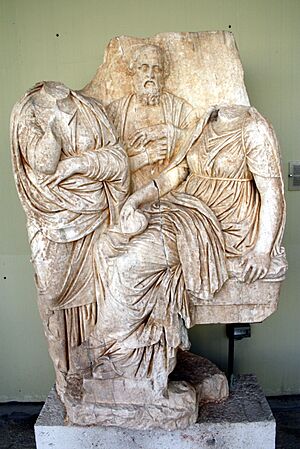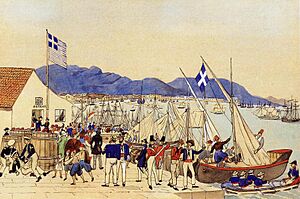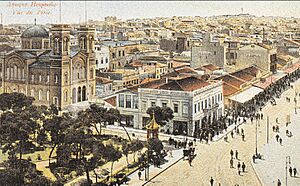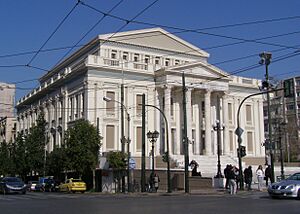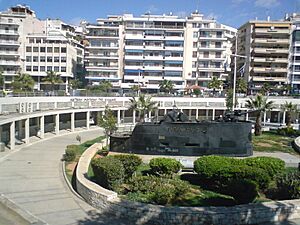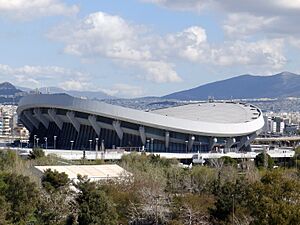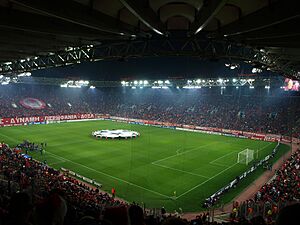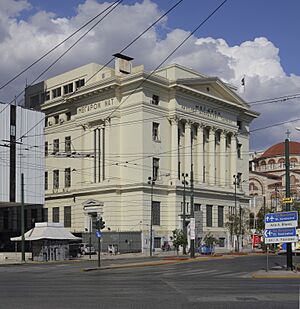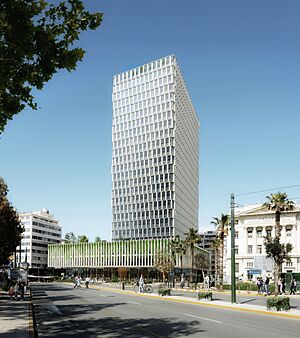Piraeus facts for kids
Quick facts for kids
Piraeus
Πειραιάς (Greek)
|
|
|---|---|
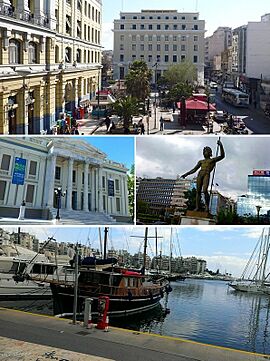
Clockwise: Piraeus station, a statue of Poseidon, Mikrolimano and Piraeus Municipal Theatre
|
|
| Country | Greece |
| Administrative region | Attica |
| Regional unit | Piraeus |
| Area | |
| • Urban | 50.417 km2 (19.466 sq mi) |
| • Municipality | 10.865 km2 (4.195 sq mi) |
| Highest elevation | 87 m (285 ft) |
| Lowest elevation | 0 m (0 ft) |
| Population
(2021)
|
|
| • Urban | 448,051 |
| • Urban density | 8,886.90/km2 (23,016.97/sq mi) |
| • Municipality | 168,151 |
| • Municipality density | 15,476.4/km2 (40,083.7/sq mi) |
| Time zone | UTC+2 (EET) |
| • Summer (DST) | UTC+3 (EEST) |
| Postal code |
185 xx
|
| Area code(s) | 21 |
| Vehicle registration | Υ |
| Website | www.piraeus.gov.gr |
| Patron saint: Saint Spyridon (12 December) | |
Piraeus (pronounced py-REE-əs or pirr-AY-əs; in Greek: Πειραιάς) is a busy port city in Greece. It's part of the larger Athens urban area, located about 8 kilometers (5 miles) southwest of Athens city center. Piraeus sits along the east coast of the Saronic Gulf.
The city of Piraeus, along with four nearby towns, forms the Piraeus regional unit. This area is sometimes called Greater Piraeus. In 2021, the total population of Greater Piraeus was about 448,051 people. Piraeus itself had 168,151 residents, making it the fifth largest city in Greece. It is the second largest city in the Athens urban area, after Athens itself.
Piraeus has a very long and interesting recorded history, going back to ancient Greece. It was founded in the early 5th century BC. The plan was to make it the new main port for Athens. A special harbor was built, bringing all of Athens' trade and navy ships to one place. During the Golden Age of Athens, huge Long Walls were built. These walls protected the path from Athens to Piraeus. In ancient times, the naval base in Piraeus could hold 372 trireme ships.
After a period of decline, Piraeus started growing again in the 19th century. This happened after Athens became the capital of Greece. Today, Piraeus is a big, lively city. It is a major center for shipping, business, and industry. It is also home to Greece's largest harbor.
The port of Piraeus is the most important port in Greece. It is the 5th largest passenger port in Europe. It is also the 24th largest passenger port in the world, serving about 4.37 million passengers in 2020. Piraeus is also one of the top ten busiest ports in Europe for container shipping. It is the busiest container port in the Eastern Mediterranean. The city hosted events during both the 1896 and 2004 Summer Olympics in Athens. The University of Piraeus is one of Greece's largest universities. It has the country's second-oldest business school.
Contents
History of Piraeus
Ancient Times and the Middle Ages
People have lived in Piraeus since at least 2600 BC. Piraeus is a rocky area on the Greek coast. It has a steep hill called Munichia and the area known today as Kastella. In ancient times, Piraeus was an island. It was connected to the mainland by a low piece of land that often flooded. This area was used as a salt field.
Over time, the land became higher and drier, and the flooding stopped. By early classical times, the land passage was always dry. Piraeus became very important because of its three deep harbors. These were the main port of Cantharus, and two smaller ones, Zea and Munichia. These harbors slowly replaced the older, shallower Phaleron harbour.
In the late 6th and early 5th centuries BC, Piraeus became a focus for important changes. In 511 BC, the hill of Munichia was made stronger by Hippias. Four years later, Piraeus became a special district of Athens called a deme. In 493 BC, Themistocles started building defenses in Piraeus. He told the Athenians to use its natural harbors instead of the sandy Phaleron bay. A small tax was charged on goods passing through the port. This helped Athens raise a lot of money.
In 483 BC, new silver was found in the Laurion mines. The money from this silver helped build 200 trireme ships. The Athenian fleet moved to Piraeus. These ships were built in its shipyards. The Athenian fleet was very important in the battle of Salamis against the Persians in 480 BC. After this, Piraeus was always used as the navy's main base.
After the second Persian invasion, Themistocles fortified the three harbors. He also built neosoikoi (ship houses). The Themistoclean Walls were finished in 471 BC. This made Piraeus a huge military and trading port. The city's defenses were later improved by the Long Walls. These walls were built under Cimon and Pericles. They protected the route from Piraeus to Athens. Piraeus was rebuilt using a famous grid plan by the architect Hippodamus of Miletus. Because of this, Piraeus grew into a very safe and busy port city.

During the Peloponnesian War, Piraeus faced problems. In 429 BC, the Athens plague spread there. In 404 BC, the Spartan fleet blocked Piraeus. Athens had to surrender to the Spartans. Piraeus suffered greatly, with its walls and the Long Walls torn down. The Athenian fleet was taken by the Spartans, and some ships were burned. This meant Piraeus could not compete with other strong trading cities like Rhodes.
In 403 BC, Thrasybulus and exiles from Phyle took Munichia. They defeated the Thirty Tyrants of Athens. Later, a general named Conon rebuilt the walls in 393 BC. He also built temples and the famous Skeuotheke (arsenal) of Philon. Piraeus started to recover during the time of Alexander the Great. However, the Roman general Lucius Cornelius Sulla destroyed Piraeus in 86 BC. The Goths under Alaric I completed the destruction in 395 AD. Piraeus then went through a long period of decline for 15 centuries. During the Byzantine period, the harbor was sometimes used for the Byzantine fleet.
In the Middle Ages, the port was often called "Port of Sithines" (meaning Athens). In the 14th century, it was called "Lion" because of a huge ancient lion statue. This statue, the Piraeus Lion, stood at the harbor's entrance. This name later became Porto Leone. Greeks also called it Porto Drako, meaning "Dragon Port".
Ottoman Period
When the Ottoman Empire took Piraeus in 1456, they called it Aslan Liman, which means "Lion Harbour".
The original Piraeus Lion statue was taken in 1687 by Francesco Morosini. He took it during a war against Athens. It is now in the Venetian Arsenal in Venice. A copy of the lion statue is on display at the Archaeological Museum of Piraeus.
Under Ottoman rule, Piraeus was mostly empty. There was only a monastery and a customs house. It was used only sometimes as a trading port. Athenians did not live in the area.
There were a few tries to build a new town, but they didn't work. It wasn't until 1829 that people started living there permanently again. Piraeus grew into a small town, mostly with fishermen. It was very different from its glorious past.
Modern Era
When the modern Greek state was created, Athens became its capital in 1832. This helped Piraeus grow again. It started to become a center for trade and industry. Many people, especially from the Aegean Islands, moved there. A plan for the town was made and approved by King Otto.
The city government was set up in 1835. It brought back the ancient name "Piraeus". The first mayor was Kyriakos Serfiotis. At this time, Piraeus had about 300 people.
Piraeus quickly became the main port and second largest city in Greece. Its good location and closeness to Athens helped it grow. Many things helped the city develop. These included being declared the main port of Greece. The Athens-Piraeus Railway was finished in 1869. Industry also grew in the 1860s. The Corinth Canal was built in 1893, making Piraeus even more important.
New buildings were constructed, like schools, churches, and a town hall. The port was also improved with dredging and new piers. By the end of the 19th century, Piraeus had 51,020 people.
The Port Committee was set up in 1911 to manage port construction. The Piraeus Port Authority was created in 1930. These groups helped the port grow even more. The city flourished, and beautiful neo-classical buildings were built. One example is the Piraeus Municipal Theatre. After the period of 1912–1922, Piraeus's population almost doubled. It went from 133,482 in 1920 to 251,659 in 1928. This was due to Greek refugees arriving from Asia Minor after the 1919–1922 Greco-Turkish War. Many new people settled in the suburbs like Nikaia and Drapetsona.
World War II caused a major setback for the city. After the war, Piraeus started to develop again. Damage to the port and city was repaired. New additions were made after 1955. Piraeus is now the fifth largest city in Greece. It is an important international port and the largest in the country.
Geography and Climate
Piraeus is in the southwest part of the central plain of Attica. This area is also known as the Attica Basin. The Athens urban area spreads across this basin. Piraeus is bordered by Mount Aigaleo to the northwest. The Saronic Gulf is to the south and west. It connects to the rest of Athens to the east and northeast.
The main part of Piraeus is a rocky peninsula. It was originally an island. It has three natural harbors. The central one was called Kantharos in ancient times. The two smaller harbors to the east are still used today. These are Zea, also known as Pasalimani, and Munichia, known as Mikrolimano. Today, Greater Piraeus includes the harbors of Drapetsona, Keratsini and Perama. The central harbor is for commercial ships and passenger ferries. The two smaller ones are for recreational boats and fishing. The city covers an area of 10.865 square kilometers (4.195 sq mi).
Climate in Piraeus
Piraeus has a hot semi-arid climate. This means it has hot, dry summers and mild, wet winters. It is the only area in Attica, Greece, that clearly falls into this climate type. The average yearly temperature is about 19.4°C (67°F).
| Climate data for Piraeus Hellenic National Meteorological Service (1981-2010) | |||||||||||||
|---|---|---|---|---|---|---|---|---|---|---|---|---|---|
| Month | Jan | Feb | Mar | Apr | May | Jun | Jul | Aug | Sep | Oct | Nov | Dec | Year |
| Mean daily maximum °C (°F) | 14.1 (57.4) |
14.4 (57.9) |
16.6 (61.9) |
20.3 (68.5) |
25.1 (77.2) |
29.9 (85.8) |
32.8 (91.0) |
32.9 (91.2) |
29.1 (84.4) |
24.2 (75.6) |
18.9 (66.0) |
15.4 (59.7) |
22.81 (73.06) |
| Daily mean °C (°F) | 11.1 (52.0) |
11.2 (52.2) |
13.3 (55.9) |
16.9 (62.4) |
21.4 (70.5) |
26.3 (79.3) |
29.0 (84.2) |
28.8 (83.8) |
25.2 (77.4) |
20.6 (69.1) |
15.8 (60.4) |
12.6 (54.7) |
19.35 (66.83) |
| Mean daily minimum °C (°F) | 8.2 (46.8) |
7.9 (46.2) |
10.0 (50.0) |
13.4 (56.1) |
17.7 (63.9) |
22.2 (72.0) |
24.8 (76.6) |
25.0 (77.0) |
21.5 (70.7) |
17.4 (63.3) |
12.9 (55.2) |
9.7 (49.5) |
15.89 (60.60) |
| Average rainfall mm (inches) | 41.95 (1.65) |
36.26 (1.43) |
34.09 (1.34) |
30.34 (1.19) |
15.95 (0.63) |
5.08 (0.20) |
5.56 (0.22) |
3.07 (0.12) |
11.37 (0.45) |
30.5 (1.20) |
58.87 (2.32) |
58.84 (2.32) |
331.9 (13.07) |
| Source: National Technical University of Athens | |||||||||||||
Population of Piraeus
Piraeus is the fifth most populated city in Greece. Its official population was 168,151 in 2021. The Greater Piraeus area, which is part of the larger Athens urban area, had a total population of 448,051 people in 2021.
The table below shows how the population of Piraeus has changed over time.
| Year | City Population | Greater Area Population |
|---|---|---|
| 1951 | 186,088 | |
| 1961 | 183,957 | |
| 1971 | 187,458 | 439,138 |
| 1981 | 196,389 | 476,304 |
| 1991 | 182,671 | 456,865 |
| 2001 | 175,697 | 466,065 |
| 2011 | 163,688 | 448,997 |
| 2021 | 168,151 | 448,051 |
Culture and Attractions
Archaeological Sites

Piraeus has many ancient sites. You can still see parts of the old Themistoclean Walls. Also, Eëtioneia, a pier at the harbor entrance, is still well-preserved. Digs in Pasalimani found the Skeuotheke. This was an ancient building where ship equipment was stored.
In Kastella, you can find the Syrangion, likely a shrine to a local hero. The Cave of Arethusa is also there, dating back to prehistoric times. You can also see ruins of the ancient city under the Agia Triada cathedral. The ancient Theater of Zea is next to the Archaeological Museum. Old ship houses (neosoikoi) from the navy yard can be seen in Zea, Munichia, and Kantharos.
Famous Bronze Statues
On July 18, 1959, four amazing bronze statues were found in Piraeus. This was a huge discovery for Greek archaeology. These statues are now at the Archaeological Museum of Piraeus. Their discovery led to the creation of the modern museum. Workers found a hand of a bronze kouros (youth) while digging. Experts were called, and more statues were uncovered. These included the Archaic Apollo, a large Artemis, a smaller Artemis, and a larger-than-life Athena.
The exact details of how they were found are not well documented. But it's thought they were carefully placed in a small room. No one knows for sure why they were hidden. One idea is that they were waiting to be shipped to Italy. Another idea is that they were hidden for safety during a war. Coins found near the statues suggest they might have been buried between the 1st century BC and the 3rd century AD. The kouros statue is of Apollo and is from the 5th century BC. The three female statues are from the 4th century BC. They show a more human style of art than the older Apollo.
Fun and Entertainment
Piraeus offers many fun things to do. There are many tavernas and restaurants famous for their food. Most are along the coasts of Mikrolimano and Piraiki. They specialize in seafood and attract many visitors. The city's nightlife is lively, with many bars and nightclubs. You can find major shopping areas on the central streets of Piraeus, Iroon Polytechneiou and Grigoriou Labraki.
In the summer, the Maritime Festival takes place. The Three Kings' Way Festival starts the carnival season with costumes and entertainment.
The Municipal Theater is a center for the arts in Piraeus. It hosts theater, dance, and music events. The outdoor Veakeio Theater in Kastella is popular in summer. It hosts concerts and shows. The Menandreio Theater, also known as Delfinario, is known for variety shows. Village Park, a large entertainment center in Agios Ioannis Renti, has many shops, cafes, and restaurants. It also has twenty cinemas, making it the largest cinema complex in Greece. Next to it, Allou Fun Park is Athens' newest and largest amusement park. It has many rides, attractions, and food places.
Museums to Visit
Piraeus has several interesting museums. The Archaeological Museum of Piraeus shows objects from classical antiquity. These items were found in Piraeus and the nearby coastal area. They tell the story of the ancient city. The city also has the Hellenic Maritime Museum. This museum has exhibits about Greece's long history with the sea. There is also the Museum of Electric Railways, located in the Piraeus station. The Municipal Art Gallery and the Municipal Library are also important cultural spots.
Sports in Piraeus
Piraeus has always been important in Greek sport. The city is home to one of Greece's most popular and successful multisport clubs, Olympiacos CFP. Another major club is Ethnikos Piraeus, which has a long sports history. Other historic clubs include Atromitos Piraeus F.C. and Peiraikos Syndesmos.
In football, Olympiacos F.C. is the most successful football club in Greece. They have won more titles than any other Greek club. Their home ground is the Karaiskakis Stadium in Neo Faliro. Ethnikos Piraeus F.C. also played in the top league for a long time. In basketball, Olympiacos B.C. is the main club from Piraeus. They are very successful in Greece and Europe. Their home arena is the Peace and Friendship Stadium. The volleyball team of Olympiacos, Olympiacos S.C., is also very strong in Greece. Piraeus is also very strong in water polo. The water polo teams of Ethnikos Piraeus and Olympiacos have won many titles in Greece. Olympiacos is the only Greek water polo club to win a European championship.
Piraeus has excellent sports facilities. The Karaiskakis Stadium was built in 1885 as a bicycle track. It was rebuilt in 2004 and is now the second largest football stadium in Greece. It can hold 33,334 people and is very modern. It hosted games for the football tournament in the 2004 Summer Olympics. The Peace and Friendship Stadium was built in 1985. It is the second largest indoor arena in Greece. It has hosted many big international sports events. These include the volleyball tournament in the 2004 Athens Olympics.
| Sport clubs based inside the bounders of Piraeus municipality | |||||
|---|---|---|---|---|---|
| Club | Founded | Sports | Achievements | ||
| Peiraikos Syndesmos | 1893 | Basketball, Volleyball, Track and Field | Panhellenic titles in women basketball | ||
| Ethnikos | 1923 | Football, Basketball, Volleyball, Water Polo and others | Panhellenic title in football, most time winner in Greek Water Polo | ||
| Olympiacos | 1925 | Football, Basketball, Volleyball, Water Polo, Track and Field and others | Arguably the most successful Greek club, many titles in several sports, most time winner in Greek football and men's volleyball | ||
| Atromitos Piraeus | 1926 | Football | Presence in Gamma Ethniki | ||
| AOF Porfyras | 1957 | Basketball, Volleyball | Presence in A1 Ethniki volleyball women | ||
Maritime Industry
Piraeus is the biggest marine shipping center in Greece. Most Greek shipowners have offices there, especially around Akti Miaouli street. Piraeus has been greatly affected by different Greek governments. After World War II, the Greek government tried to take money from insurance payments given to shipowners. These payments were for ships lost during the war. Shipowners won their case in British courts. However, many decided not to keep their main offices in Piraeus. This was because they didn't trust the government and because the area was very poor after the war. So, many Greek shipowners moved their businesses to cities like London and New York.
Today, the port of Piraeus is the 7th largest in Europe. It is the 1st in the Mediterranean for the number of containers moved each year.
Shipping Today
After the global shipping crisis around 2008, the port was slowly bought by China Ocean Shipping Company (COSCO). This is a company owned by the Chinese government. Under COSCO, Piraeus has become a very busy port. It went from moving 400,000 containers in 2008 to almost five million in 2018. Most European trade with China now goes through Greek ships, including through Piraeus.
With 8.1 million passengers in 2015, Piraeus also became the EU's sixth-largest port for passenger travel. The main port serves ferry routes to almost every island in eastern Greece. This includes Crete, the Cyclades, and the Dodecanese. The western part of the port is used for cargo. Many ferry companies use the port, such as Minoan Lines and Blue Star Ferries.
Transportation
Piraeus has a good transportation system. It is served by buses and trolleybuses. It also has the Suburban Railway. The Metro has Lines 1 and 3 that go to Piraeus. The Athens Tram also serves the city. The Piraeus station refers to the two railway stations (Metro and Suburban Railway) located near the seaport.
Landmarks to See
Piraeus has many different neighborhoods. The hill of Kastella is one of the most beautiful areas. It has great views over Athens and the Saronic Gulf. It is known for its many old, grand houses. The Veakeio Theater and a church dedicated to the Prophet Elijah are popular buildings there. The coastal area of Neo Faliro has been improved. It features the Peace and Friendship Stadium and the Karaiskakis Stadium. These are an indoor arena and a football stadium.
Mikrolimano and Bay of Zea are the smaller harbors of Piraeus. They act as marinas and attract many visitors. They are known for their beautiful views and lively nightlife. Kaminia is a working-class neighborhood. It still looks like it did in earlier times. The Municipal Theater in the center of Piraeus was built in 1885. It is an impressive old building. It is across from the Piraeus Cathedral. It is one of the city's most famous landmarks and a popular meeting spot.
Districts of Piraeus
- Agios Neilos
- Agia Sophia
- Freattyda
- Kallipoli
- Kaminia
- Kastella
- Maniatika
- Mikrolimano
- Terpsithea (Trouba)
Movies Filmed in Piraeus
Many movies have been filmed in Piraeus, including:
- Stella (1955 film)
- The Angry Hills (film)
- Never on Sunday
- The Red Lanterns
- The Burglars, starring Jean-Paul Belmondo
Twin Towns and Sister Cities
Piraeus is twinned with these cities:
Notable People from Piraeus
- Sophia Antoniadis, classical scholar
- Spyridon Manousakis (Spiros Arion), professional wrestler
- Giorgos Dalaras, singer
- Jannis Kounellis, artist
- Emmanuel Kriaras, philologist
- Dimos Moutsis, composer
- Michalis Oikonomou, painter
- Dimitrios Diamantakos, Footballer
- Dimitris Papamichael, actor
- Katina Paxinou, actress
- Dimitris Pikionis, architect
- Dimitris Rontiris, actor and director
- Costas Simitis, former Prime Minister of Greece
- Pantelis Thalassinos, singer and songwriter
- Yannis Tsarouchis, artist and painter
- Charilaos Vasilakos, Olympic medalist
- Aimilios Veakis, actor
- Thanassis Vengos, actor
- Tolis Voskopoulos, singer
- Nicola Zaccaria, Greek bass
- Dimitra Asilian, water polo player
Universities and Institutes
- University of Piraeus, started in 1938, has four schools and over 9,000 students.
Images for kids
-
Monument to Georgios Karaiskakis
See also
 In Spanish: El Pireo para niños
In Spanish: El Pireo para niños



